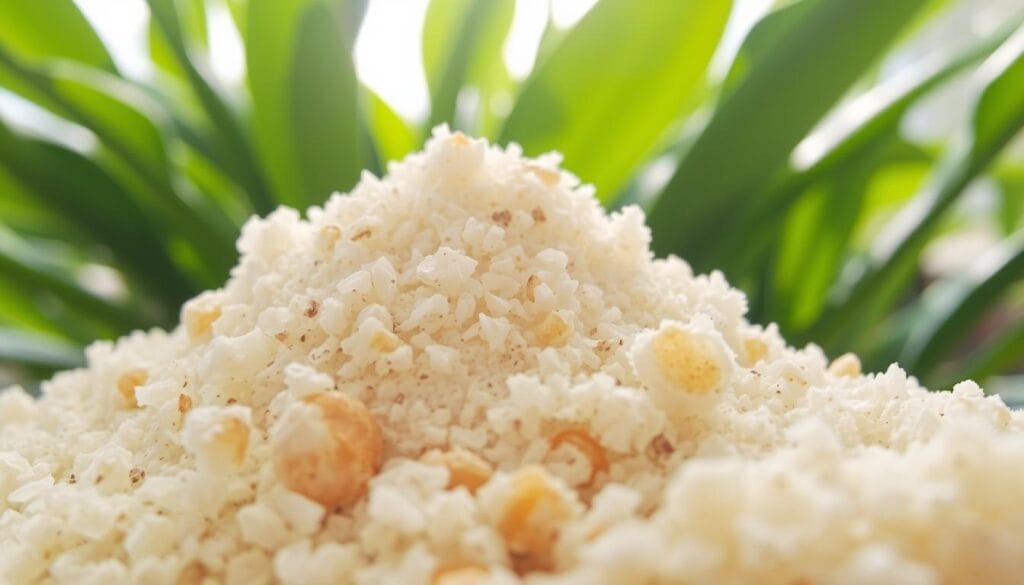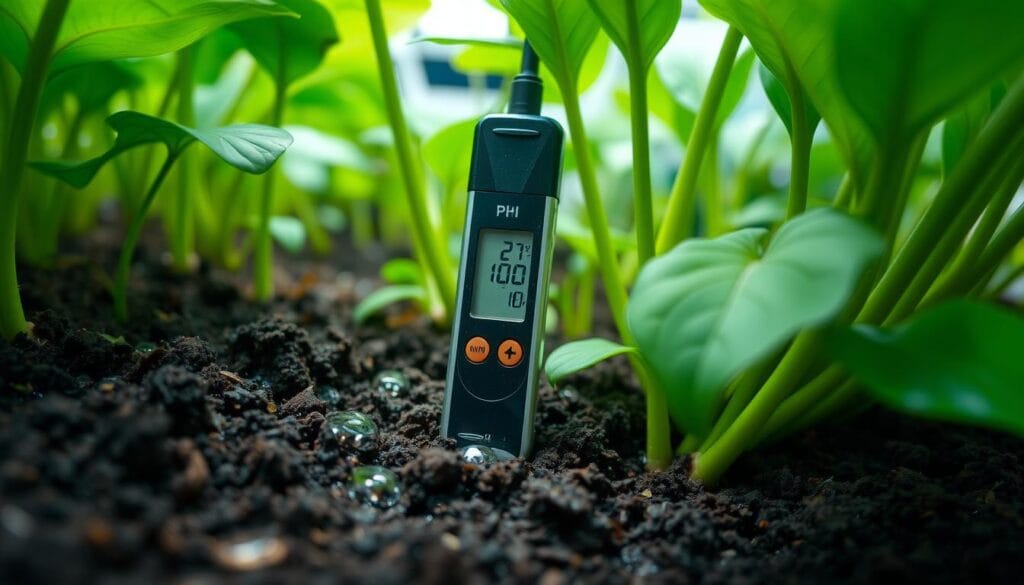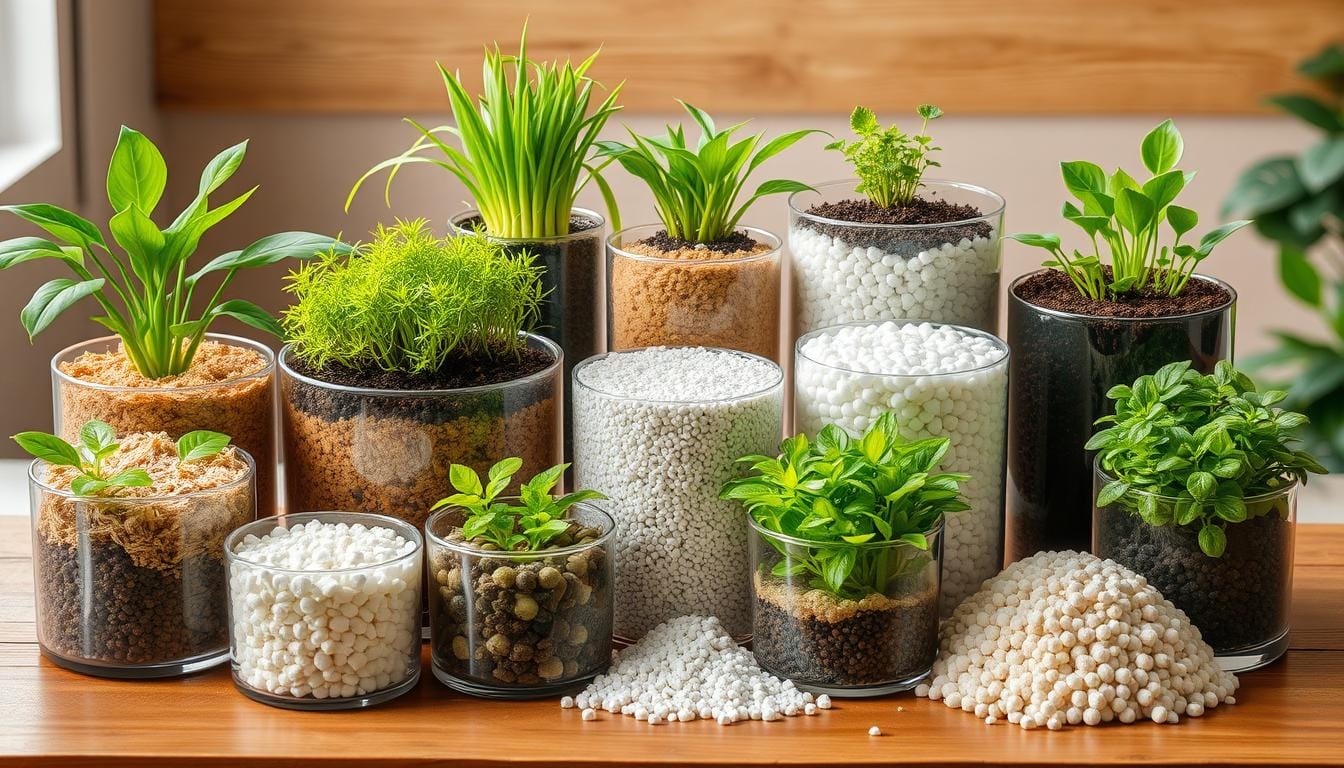I’ve always been fascinated by soilless media for perfect plant health. After years of experimenting with various materials, I’ve seen the amazing benefits of soilless cultivation. It’s a great option for both experienced growers and newcomers. Understanding soilless media can transform the health and appearance of your plants.
Key Takeaways
- Soilless growing media offer superior control over pH, nutrients, and aeration for optimal plant growth.
- Common soilless components include peat moss, coco coir, perlite, vermiculite, and more, each with unique properties.
- Soilless systems can promote faster growth, improved resource efficiency, and reduced soil-borne diseases.
- Understanding the water holding capacity and cation exchange capacity of different media is crucial for formulating the perfect mix.
- Blending various soilless components allows you to create custom growing mixes tailored to the needs of your plants.
Understanding Soilless Growing Media Fundamentals
Soilless Media for Perfect Plant Health opens up new ways to grow plants. It allows better control of nutrients, pH, and the environment, leading to healthier plants and improved growth.
Benefits of Soil-Free Cultivation
Hydroponic systems give plants the exact nutrients they need. This avoids common problems in soil gardening. You can also control pH levels better, helping plants grow well.
Key Components for Plant Success
Choosing the right growing media is key. Coco coir, perlite, and vermiculite improve aeration and water retention. Keeping an eye on temperature, humidity, and oxygen is also important for plant health.
Environmental Impact Considerations
Soilless growing has its environmental side. Media like peat moss harm ecosystems. Using sustainable options like coco coir is better for the planet.
“Soilless farming conserves resources and minimizes the environmental footprint of food production by recycling water and nutrients.”
Essential Growing Media Types and Their Properties
Soilless gardening depends a lot on the growing media you choose. From peat moss to coco coir, each has special qualities for your plants. Let’s look at the main growing media and what makes them unique.
Peat moss is great at holding water but has environmental drawbacks. Coco coir is a green option that also keeps water well.
Perlite and vermiculite improve drainage and air. Perlite helps roots grow strong, while vermiculite keeps moisture and nutrients.
Sand adds to drainage and makes the mix denser. It gives plants a solid base.
| Growing Medium | Water Retention | Aeration | pH Levels | Reusability | Environmental Impact |
|---|---|---|---|---|---|
| Peat Moss | High | Good | Acidic | Limited | Moderate |
| Coco Coir | High | Good | Neutral | Good | High |
| Perlite | Moderate | Good | Neutral | Good | Moderate |
| Vermiculite | High | Good | Neutral | Good | Moderate |
| Coarse Sand | Low | Excellent | Neutral | Excellent | High |
Each growing medium has its own strengths for water, nutrients, and plant health. Knowing these can help you make the best mix for your plants. Whether it’s peat moss, coco coir, or a mix with perlite, vermiculite, and nutrient solutions, you can create the perfect environment.
Sphagnum Peat Moss: The Traditional Choice
Sphagnum peat moss is a key player in soilless growing media. It’s known for its water retention capabilities and ability to aerate roots. Harvested from peat bogs, it’s a favorite for acid-loving plants because of its pH-friendly environment.
Water Retention Capabilities
Sphagnum peat moss can hold a lot of water. It has the ability to retain up to 20 times its own weight in water. This helps plants stay hydrated, especially in container gardens where water can be hard to manage.
pH Management Considerations
The pH of sphagnum peat moss is naturally acidic, between 3.5 and 4.5. This suits many houseplants like azaleas and orchids. But, for plants that prefer neutral or alkaline soil, you might need to add lime or other amendments.
Environmental Concerns and Alternatives
Harvesting sphagnum peat moss has raised environmental concerns. Peat bogs take a long time to regrow, and harvesting them releases stored carbon dioxide. So, coconut coir is becoming a popular, eco-friendly alternative for soilless growing media.
Knowing the pros and cons of sphagnum peat moss helps gardeners make better choices. They can balance plant health, pH balance, and environmental impact when picking the right growing medium.
Coco Coir: The Sustainable Alternative
Gardeners and horticulturists are looking for eco-friendly options. Coco coir, made from coconut husks, is a great choice. It’s a renewable resource with many benefits for growing plants.
Coco coir holds a lot of water, up to 10 times its weight. This means plants get enough water without getting too wet. It’s perfect for dry places, as you don’t need to water as often.
This material also fights off pests and fungi naturally. It’s a natural defense against common plant problems. This makes coco coir a green choice for those who want to protect the environment.
| Coco Coir Characteristics | Benefits |
|---|---|
| Excellent moisture retention | Reduced watering needs, optimal hydration |
| Natural pathogen resistance | Minimizes pests and diseases, fewer chemical treatments |
| Neutral pH range | Suitable for a wide variety of plants without pH adjustments |
| Renewable and sustainable source | Environmentally friendly alternative to peat moss |
Coco coir has a neutral pH, which is good for many plants. You don’t need to adjust the pH much. This makes it great for both hobbyists and big growers.
The need for green gardening options is rising. Coco coir is a top pick for its benefits to plants and the environment. It’s a smart choice for anyone wanting to grow healthy plants while being kind to the planet.
Soilless Media for Plant Health
Soilless growing media give growers more control over plant growth. They offer benefits like better root growth, the right amount of moisture, and precise nutrient management. These are key for healthy plants and high yields, making soilless growing media for perfect plant health an essential choice.
Nutrient Management Systems
Soilless media let growers fine-tune nutrient levels. This makes nutrient use more efficient and effective. Growers can adjust nutrient solutions at different growth stages, ensuring plants get what they need.
Aeration and Root Development
Soilless media improve aeration around roots, crucial for respiration and nutrient uptake. Their good drainage and water retention ensure roots get the right moisture. This promotes healthy growth and function.
Disease Prevention Benefits
Soilless media’s sterile nature prevents soil-borne diseases. This is key for indoor growing, where keeping the environment clean is vital for plant health and productivity.
Using soilless growing media helps growers achieve better plant health. They get robust root development, efficient nutrient use, and better disease resistance. These are all important for a thriving crop.
| Soilless Media Type | Key Properties | Ideal Applications |
|---|---|---|
| Rockwool (Stone Wool) | Excellent water and air retention, ideal for seed starting and hydroponics | Seed propagation, hydroponic systems |
| Coco Coir | pH-neutral, good water retention and drainage, can be reused after cleaning | Standalone medium or mixed with other components |
| Perlite | Lightweight and airy, enhances aeration and drainage, does not hold nutrients well | Mixed with other media to improve aeration |
| Vermiculite | Higher water retention capacity compared to perlite, can lead to waterlogged conditions | Moisture-retentive mixes, seed starting |
Understanding different soilless media’s properties and uses helps growers create the best growing environments. This unlocks the full potential of plants for optimal health and productivity.
Perlite and Vermiculite: Enhancing Drainage and Aeration
Perlite and vermiculite are key in making the best soilless growing media. They help with drainage, aeration, and water retention. These minerals add special benefits for your plants.
Perlite, made from volcanic glass, is great for drainage and aeration. It has air pockets that stop soil from getting too dense. This helps roots grow well. It’s perfect for plants that like dry soil, like succulents.
Vermiculite, on the other hand, holds a lot of water. It’s flaky and keeps moisture in, helping plants that need it. It also makes the soil easier to work with and adds nutrients.
Perlite and vermiculite help make soil better in different ways. By mixing them, gardeners can make the best mix for their plants. This mix has the right amount of drainage, aeration, and water retention for many plants.

Be careful with perlite because it can make dust. For gardening, use “horticultural grade” vermiculite. It’s safe and has less risk of health problems.
Using perlite and vermiculite is smart for growing plants without soil. They help make special mixes for different plants. This ensures they grow well and stay healthy.
Mixing and Balancing Growing Media Components
Making custom soilless media blends is all about mixing different parts in the right amounts. Basic mixes usually have equal parts of materials like sphagnum peat moss or coco coir. They also include perlite or vermiculite to balance water, air, and nutrients.
Ratio Guidelines for Different Plants
Changing these basic ratios depends on the plants’ needs. Succulents and drought-tolerant plants need more drainage. This is achieved by adding more perlite or vermiculite. On the other hand, tropical plants or those that like moist soil do better with more moss or coir.
Custom Blend Recommendations
- Microgreens do well in a 50/50 mix of coco coir and organic potting soil. This mix keeps moisture steady and provides a gentle nutrient boost.
- Hydroponic growers might choose a mix of coco coir, peat moss, vermiculite, and perlite. This creates a balanced, aerated, and nutrient-rich medium.
- Cannabis growers often use coir-based substrates. This includes pure coir or coir-perlite blends. These help with root respiration and prevent diseases.
By tailoring the custom blends to the specific plant-specific ratios, growers can make balanced mixes. These mixes help plants grow well, whether in soil-free or traditional systems.
“Soilless methods like hydroponics can make plants grow 20% faster and yield 25% more than soil gardening.”
Maintaining Optimal pH and Nutrient Levels
For plants to grow well in soilless systems, the right pH and nutrient balance are key. The ideal pH range for most plants falls between 5.5 and 6.5. This range helps them absorb nutrients better. It’s important to check the pH regularly with digital meters or test strips.
Managing nutrients is also crucial. Macronutrients like nitrogen, phosphorus, and potassium are essential for growth. Micronutrients like iron and calcium are important too. Checking the Electrical Conductivity (EC) helps track nutrient levels in the solution.
Changes in pH or nutrient levels can harm plants. Look out for signs like yellow leaves and slow growth. To keep nutrients balanced, add nutrients, flush the system, or change the solution. Regular checks and quick action are vital for healthy plants.
| Measurement | Ideal Range | Importance |
|---|---|---|
| pH | 5.5 – 6.5 | Ensures optimal nutrient availability |
| Electrical Conductivity (EC) | Varies by crop | Indicates overall nutrient concentration |
To keep plants healthy, check pH and nutrient levels often. By focusing on these, your plants will flourish in any soilless system.

“Consistent monitoring and timely interventions are the keys to thriving soilless cultivation.”
Water Management in Soilless Media Systems
Effective water management is key to successful soilless growing systems. It involves irrigation techniques and monitoring moisture levels. This ensures plants get the right amount of water and nutrients.
By understanding these methods, you can adjust your water management to fit your specific setup. This helps keep your plants healthy and productive.
Irrigation Techniques
The type of irrigation system you choose affects water efficiency and plant growth. Techniques like drip irrigation, flood and drain systems, and misting are common. Drip irrigation is very efficient, up to 95%, and works well for crops like cucumbers and tomatoes.
Flood and drain systems ensure even moisture and aeration. Misting helps keep humidity levels right and prevents water stress in sensitive plants.
Moisture Monitoring Methods
It’s important to regularly check water levels, quality, and how plants use it. This includes keeping an eye on the nutrient solution’s oxygen and temperature. Aim for a 25-30% runoff to avoid salt buildup.
Each plant needs different amounts of water. Adjusting how often and how much you water is key for their growth and productivity.

